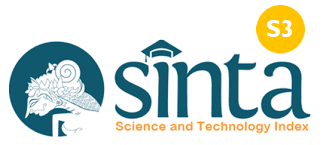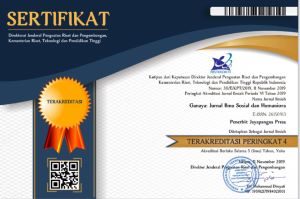Penerapan Model Pembelajaran Berbasis Masalah Berbantuan Teknik ATM Untuk Meningkatkan Prestasi Belajar Siswa
Keywords:
Problem Based Learning, ATM Technique, Learning AchievementAbstract
This study is aimed at increasing students’ learning achievement with two cycles research plan. The Subject of the study are 31 students. They are 15 male; and 16 female students. The learning achievement data are collected by using observation sheet, multiple choice test, and essay test. The data are analyzed with descriptive qualitative method. The result of the study shows that the implementation of Problem Based Learning Model with ATM technique increased the students’ learning. At the first observation data, students achievement in affective aspect students who are master 51.61%, students who have not master 48.39%; at the cognitive aspect the mean 61, the classical mastery 38.71%; at the mean of psychomotor aspect 68, classical mastery 54.84%. At cycle I the learning achievement in affective aspect 58.06%, students who have not master 41.94%; the mean of learning achievement at the cognitive aspect 89.68, classical mastery 100% the mean of learning achievement in psychomotor aspect 74.84, classical mastery 77.42%. At cycle II the learning achievement at the affective aspect Siklus II 96.77; the mean of learning achievement in cognitive aspect 84.44, classical mastery 97.09;the lmean of earning achievement in psychomotor aspect 81.77, classical mastery 100 Based on the result of the study it is suggested; (1) For Students can use this learning model to increase their learning achievement; (2) Other teachers can implement this learning model by considering the weakness of the result of the study; (3) School can use this learning model to elaborate and solve the learning problem in the class (4) Other researcher can use this research as a relavant study
References
Agustawan, G. E. 2006. Implementasi model pembelajaran berbasis masalah dalam pembelajaran fisika sebagai upaya meningkatkan kompetensi dasar fisika dan kemampuan berpikir kritis siswa kelas VIIIB SMP Negeri 2 Singaraja tahun ajaran 2005/2006. Skripsi (tidak diterbitkan). Jurusan Pendidikan Fisika, IKIP Negeri Singaraja.
Arnyana, I B. P. 2007. Penerapan model PBL pada pelajaran biologi untuk meningkatkan kompetensi dan kemampuan berpikir kritis siswa kelas X SMA Negeri 1 Singaraja tahun pelajaran 2006/2007. Jurnal Pendidikan dan Pengajaran. 40(2). 231-251.
Depdikbud. 1988. UUD 1945, P4, GBHH (TAP NO: II/MPR/1988). Jakarta: Dirjen Pendidikan Tinggi Kemdikbud.
Ibrahim, M., & Nur, M. 2000. Pengajaran berdasarkan masalah. Surabaya: Unesa Universitas Press.
Nurhadi., Yasin, B., & Senduk, A. G. 2004. Pembelajaran kontekstual (Contextual Teaching and Learning/CTL) dan penerapannya dalam KBK. Unit Penerbit Universitas Negeri Malang.
Nurkencana, I Wayan dan PPN. Sunartana. 1992. Evaluasi Hasil Belajar. Surabaya: Usaha Nasioanal.
Sanjaya, W. 2006. Strategi pembelajaran berorientasi standar proses pendidikan. Jakarta: Kencana Prenada Widia.
Sudarman. 2007. Problem based learning: suatu model pembelajaran untuk mengembangkan dan meningkatkan kemampuan memecahkan masalah. Jurnal Pendidikan Inovatif. 2(2). 68-73. Online. Dapat diakses pada http://www.jurnaljpi. files.wordpress.com/2007/09/04sudarman.pdf. (Diakses pada tanggal 26 September 2007).
Tim Kurikulum Satuan Pendidikan SMP Negeri 1 Abang. 2019. Kurikulum Satuan Pendidikan SMP Negeri 1 Abang Tapel 2019/2020. Selat: Satuan Pendidikan SMP Negeri 1 Abang.
Downloads
Published
How to Cite
Issue
Section
License
An author who publishes in the Cetta : Jurnal Ilmu Pendidikan agrees to the following terms:
- Author retains the copyright and grants the journal the right of first publication of the work simultaneously licensed under the Creative Commons Attribution-ShareAlike 4.0 License that allows others to share the work with an acknowledgement of the work's authorship and initial publication in this journal
- Author is able to enter into separate, additional contractual arrangements for the non-exclusive distribution of the journal's published version of the work (e.g., post it to an institutional repository or publish it in a book) with the acknowledgement of its initial publication in this journal.
- Author is permitted and encouraged to post his/her work online (e.g., in institutional repositories or on their website) prior to and during the submission process, as it can lead to productive exchanges, as well as earlier and greater citation of the published work (See The Effect of Open Access).
Read more about the Creative Commons Attribution-ShareAlike 4.0 Licence here: https://creativecommons.org/licenses/by-sa/4.0/.





